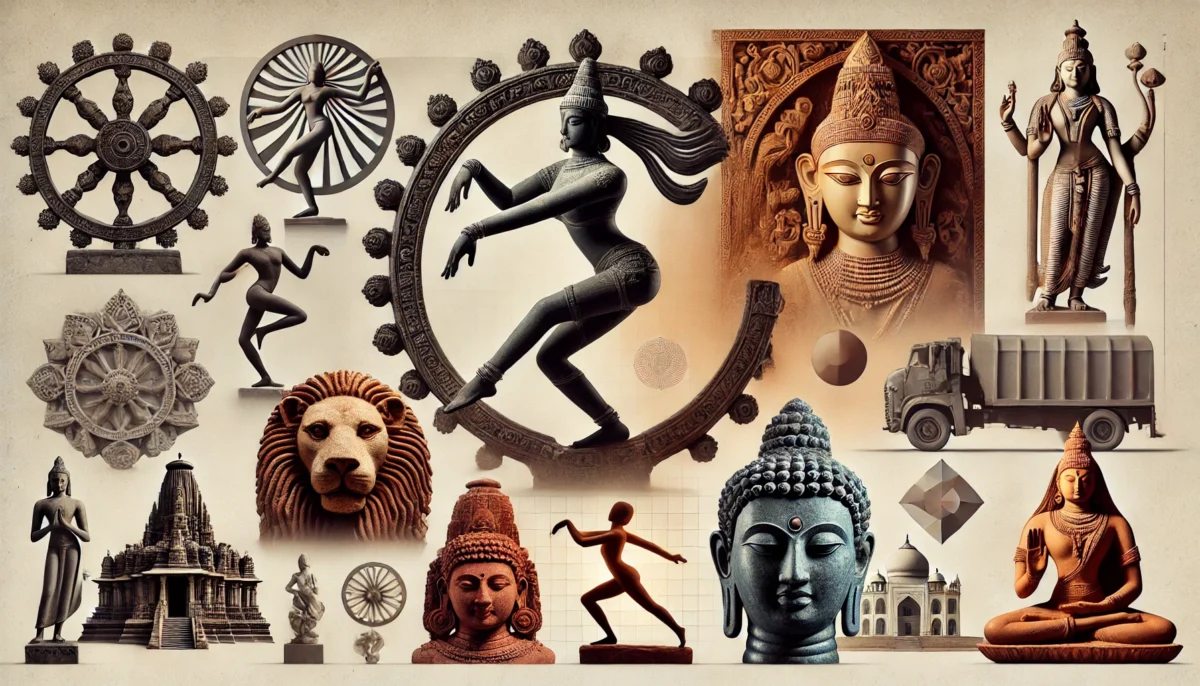The prominent art of India, Indian sculpture, is a significant part of the country’s artistic heritage, reflecting its historical, cultural, and religious diversity. It spans over several millennia, evolving with the socio-political and religious changes in the region. Here is an overview of Indian sculpture, categorized by periods and styles:
1. Indus Valley Civilization (c. 2500–1500 BCE)
- Key Features:
- Material: Terracotta, steatite, and bronze.
- Famous Works:
- Dancing Girl: A bronze figurine, depicting a young woman with confident posture and detailed ornaments.
- Priest-King: A steatite figure with intricate patterns on his robe, symbolizing authority.
- Style: Emphasis on realism and intricate detailing, especially in ornaments and expressions.

2. Mauryan Period (c. 322–185 BCE)
- Key Features:
- Material: Polished sandstone.
- Famous Works:
- Ashokan Pillars: Monolithic pillars inscribed with edicts, topped with animal capitals like the Lion Capital at Sarnath (now the national emblem of India).
- Yaksha and Yakshi Figures: Large, free-standing sculptures representing nature spirits.
- Style: Simple yet majestic, with a high degree of polish and smooth surfaces.
3. Post-Mauryan Period (c. 200 BCE–300 CE)
- Key Styles and Schools:
- Gandhara School of Art:
- Influence: Greek and Roman (Hellenistic features).
- Material: Grey schist.
- Key Features: Realistic depiction of human figures, wavy hair, and drapery with deep folds.
- Famous Works: Seated and Standing Buddhas.
- Mathura School of Art:
- Material: Red sandstone.
- Key Features: Indigenous style emphasizing robust and round figures, spiritual expression, and symbolic gestures.
- Famous Works: Buddha and Jain Tirthankara statues.
- Amaravati School of Art:
- Material: White marble.
- Key Features: Narrative panels depicting scenes from the life of Buddha.
- Famous Works: Relief sculptures from the Amaravati Stupa.
- Gandhara School of Art:
4. Gupta Period (c. 320–550 CE)
- Key Features:
- Known as the “Golden Age of Indian Art.”
- Sculptures depicted grace, spiritualism, and balance.
- Material: Sandstone.
- Famous Works:
- Standing Buddha from Sarnath: Graceful and serene.
- Hindu deities like Vishnu and Shiva, crafted with intricate details and spiritual overtones.
- Style: Idealized beauty, with emphasis on calmness and divine expressions.
5. Medieval Period (c. 600–1200 CE)
- Key Features:
- Flourishing temple architecture influenced sculptural art.
- Sculptures became integral parts of temples, serving decorative and religious purposes.
- Key Styles:
- North India: Nagara style (e.g., Khajuraho temples).
- South India: Dravidian style (e.g., Brihadeshwara Temple).
- Famous Works:
- Erotic sculptures in Khajuraho: Depicting human emotions and spiritual union.
- Chola bronzes (South India): Masterpieces like Nataraja (dancing Shiva) crafted in the lost-wax technique.
Read More: Nobel Prizes: Celebrating Excellence in Humanity
6. Islamic Period (c. 1200–1750 CE)
- Key Features:
- Decline of figurative sculptures due to Islamic influence.
- Emergence of decorative relief work with geometric and floral patterns.
- Notable Contributions: Ornamentation in monuments like the Qutub Minar and Humayun’s Tomb.
7. Colonial Period (c. 1750–1947)
- Key Features:
- Introduction of European styles, including realism and portraiture.
- Sculptures of British officials, Indian reformers, and leaders.
- Famous Works:
- Statues of Mahatma Gandhi and other freedom fighters.
8. Modern and Contemporary Period
- Key Features:
- Fusion of traditional styles with modern themes.
- Experimentation with new materials and abstract forms.
- Famous Artists:
- Ramkinkar Baij: Known for large-scale modern sculptures like “Santhal Family.”
- Anish Kapoor: Known for innovative, large-scale installations.
Themes and Symbolism
Indian sculptures often depict religious and philosophical ideas:
- Hindu Sculptures: Represent deities, cosmic principles, and epics.
- Buddhist Sculptures: Focus on the life of Buddha, Bodhisattvas, and Jataka tales.
- Jain Sculptures: Depict Tirthankaras and their meditative states.
Indian sculpture remains a living tradition, blending ancient heritage with contemporary creativity, making it a vital part of India’s cultural identity.

